January 2007
Palm brings Microsoft's Direct Push technology to more Treos
Palm announced the availability of a Microsoft Exchange ActiveSync Update for Palm OS devices for the Palm Treo 680 and 700p smartphones. The update enhances VersaMail by adding Microsoft's Direct Push Technology, allowing users connected to Microsoft Exchange Server fast, automatic wireless updates of email, calendar and contact information. In addition, Exchange ActiveSync Update for Palm OS complements Palm's Windows Mobile based Treo 700w, Treo 700wx, and the recently announced Treo 750 smartphones. [see full release] -- Posted Thursday, January 25, 2007
Neonode cleverly enters US market
Yes, everyone talks about Apple's upcoming iPhone. But Swedish Neonode has had a similar phone for years in its Neonode N1 and an impending release may well steal some of Apple's thunder. However, they had zero US market presence. This is now changing via a "reverse merger" with San Ramon, CA-based and publicly traded SBE. SBE makes IP-based network communications solutions, but it appears that the merger is more of an elegant way for Neonode to become a publicly traded US company still run by the Swedish Neonode team. -- Posted Thursday, January 25, 2007
Specialized GPS device for golfers
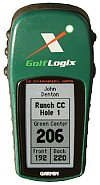 GolfLogix announced that their new consumer handheld GPS unit powered by Garmin will be introduced at the PGA Merchandise Show January 25-27, 2007 at the Orange County Convention Center in Orlando. “With the recent USGA and R&A rulings that have made GPS distance measurement devices allowable for the game of golf, handheld GPS currently represents one of the fastest growing product sales segments in the golf business,” said Scott Lambrecht, CEO of GolfLogix. The 4.4 x 2.0 x 1.2 inch device weighs just 5.3 ounces, has a 64x128 pixel display and runs for 22 hours. Unlimited worldwide golf course downloads are available with $29.95 annual membership. -- Posted Thursday, January 25, 2007
GolfLogix announced that their new consumer handheld GPS unit powered by Garmin will be introduced at the PGA Merchandise Show January 25-27, 2007 at the Orange County Convention Center in Orlando. “With the recent USGA and R&A rulings that have made GPS distance measurement devices allowable for the game of golf, handheld GPS currently represents one of the fastest growing product sales segments in the golf business,” said Scott Lambrecht, CEO of GolfLogix. The 4.4 x 2.0 x 1.2 inch device weighs just 5.3 ounces, has a 64x128 pixel display and runs for 22 hours. Unlimited worldwide golf course downloads are available with $29.95 annual membership. -- Posted Thursday, January 25, 2007
Palm OS now Garnet OS
Acess showed the new ACCESS Powered logo and announced it is renaming the Palm OS to Garnet OS. The new ACCESS Powered logo replaces the Palm Powered logo and is now used with products from both ACCESS and PalmSource, which is now known as ACCESS Systems Americas, Inc. As part of the grand renaming process, along with its previously announced agreement with Palm to sell PalmSource's rights in the Palm Trademark Holding Company to Palm, ACCESS is renaming all products that originally had Palm-based names. At the 2007 3GSM World Congress, ACCESS will showcase the ACCESS Linux Platform, NetFront Browser, and the NetFront Mobile Client Suite. -- Posted Thursday, January 25, 2007
Intel's UMD platform to replace VIA?
An article in Digitimes speculates about Intel's plans to promote its ultra-mobile device platform, UMD, and how this could spell steep competition for VIA which has been successful with its low cost/low power C7-M UMPC platform. The article suggests UMPCs being "one of the hottest topics in the market" but also points out that high prices have seriously hampered acceptance of the UMPC platform. Our take: As long as pen/touch products command a price premium, and most do, they will continue to be niche products. -- Posted Monday, January 22, 2007
Wyse introduces interesting new "thin computers"
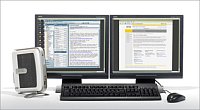 Wyse Technology, a leader in Thin Computing, today announced the availability of the new Wyse V-Class Dual-Video family of thin computers with advanced display capabilities. The V-Class Dual-Video family addresses the requirements of customers asking for higher display resolutions (up to WUXGA 1920 x 1080 pixels), superior image quality, and support for analog and digital displays through a DVI-I interface. It is based on the VIA Eden C7 processor, uses only 12 watts of power, yet is four times faster than the models it replaces, at the same or lower prices. The line includes models based on Windows CE 5.0, Linux, and Windows XP embedded. Models are available starting at $399. Dual video capability requires optional DVI-I to dual display cable. -- Posted Tuesday, January 16, 2007
Wyse Technology, a leader in Thin Computing, today announced the availability of the new Wyse V-Class Dual-Video family of thin computers with advanced display capabilities. The V-Class Dual-Video family addresses the requirements of customers asking for higher display resolutions (up to WUXGA 1920 x 1080 pixels), superior image quality, and support for analog and digital displays through a DVI-I interface. It is based on the VIA Eden C7 processor, uses only 12 watts of power, yet is four times faster than the models it replaces, at the same or lower prices. The line includes models based on Windows CE 5.0, Linux, and Windows XP embedded. Models are available starting at $399. Dual video capability requires optional DVI-I to dual display cable. -- Posted Tuesday, January 16, 2007
Apple iPhone and NeoNode
When I saw Steve Jobs introduce the upcoming iPhone, I couldn't help but think back of a device that we reviewed in detail early last year, the NeoNode N1. It's been around for a few years and a much updated version is rumored to be just around the corner. The interface? Special touchscreen. Keyboard? None. All swipes. Unlock? Swiping. Operating? Icons and swipes. Music and video? Check. [Read about the NeoNode and its interface] -- Posted Monday, January 15, 2007
AT&T to phase out Cingular
AT&T will phase out the Cingular brand in favor of using its own name. That's after Cingular spent a billion or so on popularizing the name. AT&T, of course, is also not quite AT&T. It's essentially SBC Communications, which had been taking over the shell that was left of the once mighty AT&T, but decided to assume the AT&T name. Cingular, meanwhile, had bought AT&T Wireless back in 2004, but phased out that name due to AT&T Wireless's exceedingly poor reputation. Remember legendary Jefferson Starship singer in their megahit "We built this city"? -- "Someone's always playing corporation games. Who cares they're always changing corporation names." -- Posted Friday, January 12, 2007
First ever Mac Tablet solution
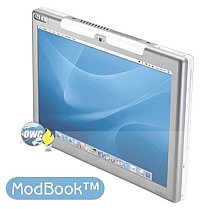 Other World Computing and Axiotron unveiled the ModBook, the first ever Mac OS X tablet computer solution. The Axiotron ModBook is an after-market hardware modification solution of the Apple MacBook, adding WACOM pen input, a new 13.3" wide screen LCD and an optional GPS in a satin-finish, chrome-plated magnesium top shell, while keeping all the powerful features of the MacBook base system and that includes Inkwell handwriting and gesture recognition which is built into OS X and works in all applications. The ModBook can be preordered in three versions, ranging from US$2,199 to US$2,699, or roughly double that of the corresponding MacBooks, though the prices are not directly comparable due to different equipment levels. [see ModBook lineup] -- Posted Thursday, January 11, 2007
Other World Computing and Axiotron unveiled the ModBook, the first ever Mac OS X tablet computer solution. The Axiotron ModBook is an after-market hardware modification solution of the Apple MacBook, adding WACOM pen input, a new 13.3" wide screen LCD and an optional GPS in a satin-finish, chrome-plated magnesium top shell, while keeping all the powerful features of the MacBook base system and that includes Inkwell handwriting and gesture recognition which is built into OS X and works in all applications. The ModBook can be preordered in three versions, ranging from US$2,199 to US$2,699, or roughly double that of the corresponding MacBooks, though the prices are not directly comparable due to different equipment levels. [see ModBook lineup] -- Posted Thursday, January 11, 2007
i-mate to sell PDAL and JAQ3 in the US
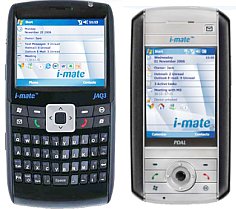 At CES, i-mate announced that it would now market its unlocked PDAL and JAQ3 Windows 5.0 devices in the US. Both are small and handy GSM quad-band phone/Pocket PCs powered by 200MHz OMAP 860 processors. Both have 128MB ROM/64MB RAM, Bluetooth, 802.11b/g, a 2 megapixel digital camera, a 2.4-inch 320x240 pixel display, and use a Micro-SD card slot. The JAQ3 is a little larger (5 x 2.7 x 0.55 inches) due to its full QWERTY thumb-type keyboard. The PDAL has a conventional PDA design and measures 4.45 x 2.2 x 0.6 inches. Both use Microsoft Direct Push (requires MS Exchange Server). What does it mean? That i-mate is adding yet more WinMo devices to its already formidable PDA/PDA phone lineup. -- Posted Wednesday, January 10, 2007
At CES, i-mate announced that it would now market its unlocked PDAL and JAQ3 Windows 5.0 devices in the US. Both are small and handy GSM quad-band phone/Pocket PCs powered by 200MHz OMAP 860 processors. Both have 128MB ROM/64MB RAM, Bluetooth, 802.11b/g, a 2 megapixel digital camera, a 2.4-inch 320x240 pixel display, and use a Micro-SD card slot. The JAQ3 is a little larger (5 x 2.7 x 0.55 inches) due to its full QWERTY thumb-type keyboard. The PDAL has a conventional PDA design and measures 4.45 x 2.2 x 0.6 inches. Both use Microsoft Direct Push (requires MS Exchange Server). What does it mean? That i-mate is adding yet more WinMo devices to its already formidable PDA/PDA phone lineup. -- Posted Wednesday, January 10, 2007
Apple announces the iPhone
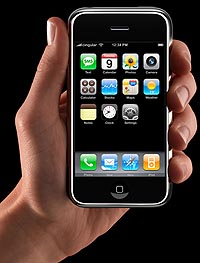 During his MacWorld 20007 keynote, Steve Jobs announced that they'll introduce three revolutionary new products. a widescreen iPod with touch controls, a revolutionary new mobile phone, and a breakthrough internet communications device. Turns out it is one device, the much rumored iPhone, a device for which they filed for over 200 patents.
During his MacWorld 20007 keynote, Steve Jobs announced that they'll introduce three revolutionary new products. a widescreen iPod with touch controls, a revolutionary new mobile phone, and a breakthrough internet communications device. Turns out it is one device, the much rumored iPhone, a device for which they filed for over 200 patents.
iPhone is a slim (0.45 inches) rectangular device with rounded corners that's almost all screen. The design is elegant-minimalist, like so many Apple products. The screen is 3.5 inches diagonally, which makes the whole device 2.2 x 4.5 inches, as wide as a RAZR, but longer. Weight is 4.8 ounces. The screen is 160 dpi, with 480 x 320 resolution. The iPhone has a 2-megapixel camera, a SIM slot as it is a Quad-Band GSM and EDGE phone. The iPhone is not a 3G device, but has Bluetooth and WiFi. It actually runs OSX, so industrial strength applications can run on it, and it has 4 or 8GB of memory.
There is a 3.5mm jack, an iPod connector, and three sensors. One is a proximity sensor that shuts off the screen and touchscreen when the phone nears the ear. The second is an ambient light sensor that adjusts the screen. The third is an accelerometer that can sense portrait and landscape orientation.
The "multi-touch" touchscreen uses the finger instead of a stylus. It has a cool interface that uses buttons and also has an onscreen QWERTY keyboard with predictive input if you need it. Since it runs OSX, it has the Safari browser, IMAP and pop3 email, Google maps, Widgets, various mail clients, messaging, calendar, photos, and, of course, the phone app. Yahoo offers free push-iMAP for the iPhone, essentially Blackberry technology. The battery is good for 5 hours of talk tie and 16 hours of audio playback.
As far as physical controls go, there's just one, the "home" button. There is a sleep/wake switch, speaker, mic input. To unlock the phone you run your finger over it. Colorful icons show up. There are also touch control overlays, whatever works best for a given application.
If you use it as an iPod, the widescreen makes for great video, the built-in speaker is something a lot will appreciate, and there is "CoverFlow." As a phone, you can use stereo headphones with a small dongle in the wire, a microphone and a switch.
The iPhone will debut in June. So why did Apple pre-announce? Because anything submitted to the FCC will be published and scooped anyway, so they probably did the right thing, and it's not like it's pre-empting an existing model. The relationship will be exclusively with Cingular, which is part of the "new" AT&T. The price will be US$499 with a service contract for the 4GB model, and an 8GB model is US$599 with a 2-year contract.
What plans does Apple have with the iPhone? Well, the phone market was a billion units in 2006, and APple expects a one percent penetration in 2008, so that'd be ten million iPhones.
Interestingly, Apple also changed its name to reflect the fact that iPod, the also announced Apple TV and now the iPhone are such a prominent part of its lineup. So it will no longer be Apple Computer, Inc, just Apple, Inc. -- Posted Tuesday, January 9, 2007
InPlay offers digital pen technology for UMPCs
InPlay Technologies announced that its digital pen technology now offers OEMs pen-input capability for ultra-mobile PCs. The InPlay MagicPoint for UMPCs consists of a digitizer behind a 7-inch LCD and an active RF digital writing pen. The system is customizable from a low-cost corded pen with basic handwriting input capability to a feature-rich cordless digital pen. The active RF pen adds greater accuracy and enhanced functionality such as hover, tilt and pressure sensitivity versus a passive stylus. "InPlay's MagicPoint technology can also be leveraged beyond the tablet PC, our primary market today. Our goal is to enable active RF pen-input as a standard user interface across all mobile PC devices," said Bob Brilon, CEO, InPlay Technologies. InPlay's MagicPoint technology is the only pen input solution with digital stream communication available today. -- Posted Tuesday, January 9, 2007
Seamless Internet S-XGen device
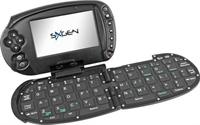 Seamless Internet, Inc. WiFi operater showed the S-XGen a 6.5 x 4.1 x 1.25-inch device the company calls an Ultra Mobile Personal Computer (UMPC) with integrated Cellular, Wi-Fi and Bluetooth communications. CBL Consulting of Brooklyn, NY has supposedly already ordered 500 of the devices that sport an unusual, yet not unprecendented folding keyboard. It's powered by a 520MHz version of the PXA270 processor, has 256MB of RAM and a 20GB drive. The 4-inch display has an unusual 470 x 280 pixel resolution and the US$1,400 unit runs Windows CE 5.0 with the Office Mobile Suite. We wouldn't call this a UMPC, but it's certainly an interesting device. [ASee a video of the device] -- Posted Tuesday, January 9, 2007
Seamless Internet, Inc. WiFi operater showed the S-XGen a 6.5 x 4.1 x 1.25-inch device the company calls an Ultra Mobile Personal Computer (UMPC) with integrated Cellular, Wi-Fi and Bluetooth communications. CBL Consulting of Brooklyn, NY has supposedly already ordered 500 of the devices that sport an unusual, yet not unprecendented folding keyboard. It's powered by a 520MHz version of the PXA270 processor, has 256MB of RAM and a 20GB drive. The 4-inch display has an unusual 470 x 280 pixel resolution and the US$1,400 unit runs Windows CE 5.0 with the Office Mobile Suite. We wouldn't call this a UMPC, but it's certainly an interesting device. [ASee a video of the device] -- Posted Tuesday, January 9, 2007
Edgy new Toshiba R400 Tablet PC
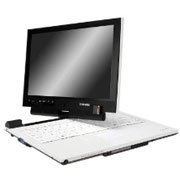 Toshiba maintained its position as perhaps the premier provider of Tablet PC convertibles with the introduction of the Portege R400, a somewhat edgy design clearly meant to ring in the Vista era. The machine runs a 1.2 GHz Intel Core Duo U2500, uses the currently popular 1280 x 800 "wide" format in a wide-viewing-angle 12.1-inch LCD, has 2-4GB of PC4200 RAM, an 80GB hard disk, a DVD writer, integrated EV-DO/Bluetooth/802.11a/b/g, measures 12 x 9.5 x 1.2 inches and weighs just under four pounds. The black and white color schem departs from recent Toshiba designs, as does a secondary display for the display of mail and calendar data along the front of the device. There is also a wireless replicator and Toshiba claims the R400 is the first notebook compatible with Microsoft Active Notification that synchronizes email with the calendar on its own. -- Posted Tuesday, January 9, 2007
Toshiba maintained its position as perhaps the premier provider of Tablet PC convertibles with the introduction of the Portege R400, a somewhat edgy design clearly meant to ring in the Vista era. The machine runs a 1.2 GHz Intel Core Duo U2500, uses the currently popular 1280 x 800 "wide" format in a wide-viewing-angle 12.1-inch LCD, has 2-4GB of PC4200 RAM, an 80GB hard disk, a DVD writer, integrated EV-DO/Bluetooth/802.11a/b/g, measures 12 x 9.5 x 1.2 inches and weighs just under four pounds. The black and white color schem departs from recent Toshiba designs, as does a secondary display for the display of mail and calendar data along the front of the device. There is also a wireless replicator and Toshiba claims the R400 is the first notebook compatible with Microsoft Active Notification that synchronizes email with the calendar on its own. -- Posted Tuesday, January 9, 2007
Bye PC Card, hello ExpressCard
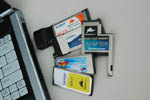 If you bought a notebook recently and found a PC Card slot in it but your PC Cards didn't fit, it's because it's an ExpressCard slot. At CES in Las Vegas, PCMCIA, the leading technology trade association for PC Card technology, announced that the newest wave of ExpressCard notebook computers, modules and components are now available. The latest products dramatically increase the number and variety of applications available to consumers today, and range from wireless WAN to TV tuners, gigabit Ethernet, high-capacity data storage, a wireless mouse and expansion solutions. Check out the ExpressCard site] -- Posted Monday, January 8, 2007
If you bought a notebook recently and found a PC Card slot in it but your PC Cards didn't fit, it's because it's an ExpressCard slot. At CES in Las Vegas, PCMCIA, the leading technology trade association for PC Card technology, announced that the newest wave of ExpressCard notebook computers, modules and components are now available. The latest products dramatically increase the number and variety of applications available to consumers today, and range from wireless WAN to TV tuners, gigabit Ethernet, high-capacity data storage, a wireless mouse and expansion solutions. Check out the ExpressCard site] -- Posted Monday, January 8, 2007
Mobile Television now interactive!
MobiTV, Inc., a global leader in mobile and broadband television and music services, announced a new version of the MobiTV service that includes interactive features. This new version of MobiTV scheduled to debut in February 2007, provides carriers, content partners and advertisers more compelling ways to interact with and entertain television subscribers. "Not only have we launched the latest in a series of feature-rich MobiTV service updates, we have connected the dots between advertisers, the entertainment industry, and consumers to make everyone's media experience more relevant and meaningful," said Dr. Phillip Alvelda, CEO, chairman and co-founder of MobiTV. "We pride ourselves on leading the convergence of the television, wireless and pc markets and this new release is a tremendous win for everyone." [Check MobiTV page] -- Posted Monday, January 8, 2007
HP introduces tx1000 Vista-optimized Tablet PC
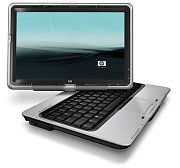 At CES, HP announced the Pavilion tx1000 entertainment notebook PC, the first consumer Tablet PC optimized for Microsoft Windows Vista. The tx1000 features a swivel digitizer display, built-in remote control, HP QuickPlay instant movie viewing, and, um... karaoke. The tx1000 runs on an 1.8 GHz AMD Turion X2 dual core mobile processor, has up to 2GB DDR2 RAM, measures 8.8 x 12.1 x 1.25 inches and weighs 4.25 pounds. There is a 160GB 5400rpm hard disk, 802.11b/g WiFi, an 8X double-layer DVD burner, and prices start at a low US$1,099. -- Posted Monday, January 8, 2007
At CES, HP announced the Pavilion tx1000 entertainment notebook PC, the first consumer Tablet PC optimized for Microsoft Windows Vista. The tx1000 features a swivel digitizer display, built-in remote control, HP QuickPlay instant movie viewing, and, um... karaoke. The tx1000 runs on an 1.8 GHz AMD Turion X2 dual core mobile processor, has up to 2GB DDR2 RAM, measures 8.8 x 12.1 x 1.25 inches and weighs 4.25 pounds. There is a 160GB 5400rpm hard disk, 802.11b/g WiFi, an 8X double-layer DVD burner, and prices start at a low US$1,099. -- Posted Monday, January 8, 2007
Fujitsu Siemens introduces Pocket LOOX N100
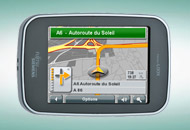 Fujitsu Siemens unveiled the co-developed Pocket LOOX N100 to the U.S. market at CES. Designed as a personal navigation device (PND), the Pocket LOOX is just 0.6 inches thick and weighs 3.9 ounces, making it the thinnest and smallest multifunctional PND available. It has a 2.8 inch color screen, a five-hour rechargeable Li-Ion battery, an MP3 player, video player, photo viewer and games in a trendy design that can hang off a keychain. The Pocket LOOX guarantees one-click operation; directed by NAVIGON's customized MobileNavigator Premium software featuring touch screen capabilities and a multilingual user interface. The Pocket LOOX will be available in Spring 2007 for $499. [see full LOOX n100 page] -- Posted Monday, January 8, 2007
Fujitsu Siemens unveiled the co-developed Pocket LOOX N100 to the U.S. market at CES. Designed as a personal navigation device (PND), the Pocket LOOX is just 0.6 inches thick and weighs 3.9 ounces, making it the thinnest and smallest multifunctional PND available. It has a 2.8 inch color screen, a five-hour rechargeable Li-Ion battery, an MP3 player, video player, photo viewer and games in a trendy design that can hang off a keychain. The Pocket LOOX guarantees one-click operation; directed by NAVIGON's customized MobileNavigator Premium software featuring touch screen capabilities and a multilingual user interface. The Pocket LOOX will be available in Spring 2007 for $499. [see full LOOX n100 page] -- Posted Monday, January 8, 2007
Trimble introduces outdoor navigation solution for GPS phones
Trimble today introduced its GuideWorx GPS application, further extending its Trimble Outdoors suite of GPS-on-cellular applications and demonstrating the company's leading position in the location-based applications space. GuideWorx GPS transforms a mobile phone into a powerful handheld GPS device specifically designed for both on- and off-road navigation. [see full release] -- Posted Monday, January 8, 2007
Gates shows OQO 02 in his keynote
 Bill Gates showcased OQO’s next gen ultra-mobile PC, the model 02, in his keynote address at CES. Weighing a pound and small enough to fit in a pocket, the model 02 is the world’s smallest Windows Vista capable computer. The model 02 is up to four times faster and has a display more than six times brighter than its predecessor, the model 01+. Redesigned from the ground up, the model 02 features a new ergonomic backlit keyboard and capacitive TouchScrollers for easy input and navigation. The model 02 has EV-DO Wireless WAN, WiFi, and Bluetooth and starts at $1,499. The model 02 has a 1.5GHz CPU, 60GB hard disk, 1GB of RAM. [see the OQO model 02] -- Posted Monday, January 8, 2007
Bill Gates showcased OQO’s next gen ultra-mobile PC, the model 02, in his keynote address at CES. Weighing a pound and small enough to fit in a pocket, the model 02 is the world’s smallest Windows Vista capable computer. The model 02 is up to four times faster and has a display more than six times brighter than its predecessor, the model 01+. Redesigned from the ground up, the model 02 features a new ergonomic backlit keyboard and capacitive TouchScrollers for easy input and navigation. The model 02 has EV-DO Wireless WAN, WiFi, and Bluetooth and starts at $1,499. The model 02 has a 1.5GHz CPU, 60GB hard disk, 1GB of RAM. [see the OQO model 02] -- Posted Monday, January 8, 2007
Samsung shows double-sided LCD
Samsung is showing a 2-1/4-inch double-sided LCD at CES 2007. It is the first product to display two different images back to back in an ultra-thin package, opening the possibility for truly innovative and different multimedia handset designs. Other commercially available double-sided LCDs consist of two panels placed one on top of the other, and those only display the reverse image of identical screen content. -- Posted Monday, January 8, 2007
Mio shows new DigiWalker C250 and C520, others
 At CES, Mio Technology showed the new Mio DigiWalker C520, a widescreen portable navigation and entertainment device, the C250, an entry-level, easy-to-use GPS device with an MP3 player, and the H610 (shown left), a hot high-tech gift this past holiday season. The C520 has a widescreen 4.3" display and a low-profile design that nicely integrates into the styling of an automotive cockpit. The C520 uses Bluetooth and a split-screen display to allows for address lookup or route information while the map is visible. The C250 is ideal for anyone looking for real-time directions or entertainment while driving, whether they're new to GPS or simply looking for a full-featured, value-packed device. The pocket-sized black unit has a 3.5" touch-screen. The recently updated entry-level DigiWalker C310x is another product sure to attract attention in the booth. [See all Mio Digiwalkers] -- Posted Monday, January 8, 2007
At CES, Mio Technology showed the new Mio DigiWalker C520, a widescreen portable navigation and entertainment device, the C250, an entry-level, easy-to-use GPS device with an MP3 player, and the H610 (shown left), a hot high-tech gift this past holiday season. The C520 has a widescreen 4.3" display and a low-profile design that nicely integrates into the styling of an automotive cockpit. The C520 uses Bluetooth and a split-screen display to allows for address lookup or route information while the map is visible. The C250 is ideal for anyone looking for real-time directions or entertainment while driving, whether they're new to GPS or simply looking for a full-featured, value-packed device. The pocket-sized black unit has a 3.5" touch-screen. The recently updated entry-level DigiWalker C310x is another product sure to attract attention in the booth. [See all Mio Digiwalkers] -- Posted Monday, January 8, 2007
Nokia releases Linux-based N800 internet device
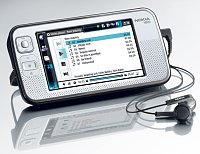 At CES, Nokia introduced its next generation widescreen Nokia Nseries multimedia computer, the Nokia N800 Internet Tablet that combines Internet access with wireless connections, a high res display and support for many Internet applications. The Nokia N800 is built to be constantly in use with Internet calling, IM and email. With stereo audio and media support the N800 is a portable Internet entertainment device. Building on the Nokia 770, the N800 is faster performance, has a full screen finger qwerty keyboard, easier continuous connections through WiFi or via Bluetooth phone, integrated web camera as well as a new elegant design. Nokia also announced that Skype will become available on the Linux based Nokia N800.
At CES, Nokia introduced its next generation widescreen Nokia Nseries multimedia computer, the Nokia N800 Internet Tablet that combines Internet access with wireless connections, a high res display and support for many Internet applications. The Nokia N800 is built to be constantly in use with Internet calling, IM and email. With stereo audio and media support the N800 is a portable Internet entertainment device. Building on the Nokia 770, the N800 is faster performance, has a full screen finger qwerty keyboard, easier continuous connections through WiFi or via Bluetooth phone, integrated web camera as well as a new elegant design. Nokia also announced that Skype will become available on the Linux based Nokia N800.
-- Posted Monday, January 8, 2007
Nokia releases N93i camcorder/multimedia phone
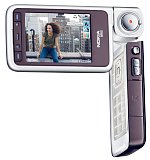 Nokia introduced the Nokia N93i, a stylish digital camcorder and multimedia computer in one. Its VOX video and photo blogging service lets you share stories and thoughts with others across the world. Select video or photos in a gallery and upload them directly from the n93i to Vox in their original size. For advanced editing, the N93i comes bundled with Adobe Premiere Elements 3.0. Videos can then be transferred back to your multimedia computer or burned to DVDs. The Nokia N93i is designed to work on WLAN, 3G (WCDMA 2100 MHz), EDGE and GSM (900/1800/1900 MHz) networks. You can play MP3 music, podcasts, stereo FM radio or mobile TV video streaming. Slimmer and more compact in design, the Nokia N93i follows on the success of the Nokia N93. The Nokia N93i is based on Symbian S60 3rd Edition and, is expected to start shipping in volumes during the first quarter of 2007. -- Posted Monday, January 8, 2007
Nokia introduced the Nokia N93i, a stylish digital camcorder and multimedia computer in one. Its VOX video and photo blogging service lets you share stories and thoughts with others across the world. Select video or photos in a gallery and upload them directly from the n93i to Vox in their original size. For advanced editing, the N93i comes bundled with Adobe Premiere Elements 3.0. Videos can then be transferred back to your multimedia computer or burned to DVDs. The Nokia N93i is designed to work on WLAN, 3G (WCDMA 2100 MHz), EDGE and GSM (900/1800/1900 MHz) networks. You can play MP3 music, podcasts, stereo FM radio or mobile TV video streaming. Slimmer and more compact in design, the Nokia N93i follows on the success of the Nokia N93. The Nokia N93i is based on Symbian S60 3rd Edition and, is expected to start shipping in volumes during the first quarter of 2007. -- Posted Monday, January 8, 2007
 GolfLogix announced that their new consumer handheld GPS unit powered by Garmin will be introduced at the PGA Merchandise Show January 25-27, 2007 at the Orange County Convention Center in Orlando. “With the recent USGA and R&A rulings that have made GPS distance measurement devices allowable for the game of golf, handheld GPS currently represents one of the fastest growing product sales segments in the golf business,” said Scott Lambrecht, CEO of GolfLogix. The 4.4 x 2.0 x 1.2 inch device weighs just 5.3 ounces, has a 64x128 pixel display and runs for 22 hours. Unlimited worldwide golf course downloads are available with $29.95 annual membership. -- Posted Thursday, January 25, 2007
GolfLogix announced that their new consumer handheld GPS unit powered by Garmin will be introduced at the PGA Merchandise Show January 25-27, 2007 at the Orange County Convention Center in Orlando. “With the recent USGA and R&A rulings that have made GPS distance measurement devices allowable for the game of golf, handheld GPS currently represents one of the fastest growing product sales segments in the golf business,” said Scott Lambrecht, CEO of GolfLogix. The 4.4 x 2.0 x 1.2 inch device weighs just 5.3 ounces, has a 64x128 pixel display and runs for 22 hours. Unlimited worldwide golf course downloads are available with $29.95 annual membership. -- Posted Thursday, January 25, 2007 Wyse Technology, a leader in Thin Computing, today announced the availability of the new
Wyse Technology, a leader in Thin Computing, today announced the availability of the new  Other World Computing and Axiotron unveiled the ModBook, the first ever Mac OS X tablet computer solution. The Axiotron ModBook is an after-market hardware modification solution of the Apple MacBook, adding WACOM pen input, a new 13.3" wide screen LCD and an optional GPS in a satin-finish, chrome-plated magnesium top shell, while keeping all the powerful features of the MacBook base system and that includes Inkwell handwriting and gesture recognition which is built into OS X and works in all applications. The ModBook can be preordered in three versions, ranging from US$2,199 to US$2,699, or roughly double that of the corresponding MacBooks, though the prices are not directly comparable due to different equipment levels. [
Other World Computing and Axiotron unveiled the ModBook, the first ever Mac OS X tablet computer solution. The Axiotron ModBook is an after-market hardware modification solution of the Apple MacBook, adding WACOM pen input, a new 13.3" wide screen LCD and an optional GPS in a satin-finish, chrome-plated magnesium top shell, while keeping all the powerful features of the MacBook base system and that includes Inkwell handwriting and gesture recognition which is built into OS X and works in all applications. The ModBook can be preordered in three versions, ranging from US$2,199 to US$2,699, or roughly double that of the corresponding MacBooks, though the prices are not directly comparable due to different equipment levels. [ At CES,
At CES,  During his MacWorld 20007 keynote, Steve Jobs announced that they'll introduce three revolutionary new products. a widescreen iPod with touch controls, a revolutionary new mobile phone, and a breakthrough internet communications device. Turns out it is one device, the much rumored iPhone, a device for which they filed for over 200 patents.
During his MacWorld 20007 keynote, Steve Jobs announced that they'll introduce three revolutionary new products. a widescreen iPod with touch controls, a revolutionary new mobile phone, and a breakthrough internet communications device. Turns out it is one device, the much rumored iPhone, a device for which they filed for over 200 patents. 
 Toshiba maintained its position as perhaps the premier provider of Tablet PC convertibles with the introduction of the Portege R400, a somewhat edgy design clearly meant to ring in the Vista era. The machine runs a 1.2 GHz Intel Core Duo U2500, uses the currently popular 1280 x 800 "wide" format in a wide-viewing-angle 12.1-inch LCD, has 2-4GB of PC4200 RAM, an 80GB hard disk, a DVD writer, integrated EV-DO/Bluetooth/802.11a/b/g, measures 12 x 9.5 x 1.2 inches and weighs just under four pounds. The black and white color schem departs from recent Toshiba designs, as does a secondary display for the display of mail and calendar data along the front of the device. There is also a wireless replicator and Toshiba claims the R400 is the first notebook compatible with Microsoft Active Notification that synchronizes email with the calendar on its own. -- Posted Tuesday, January 9, 2007
Toshiba maintained its position as perhaps the premier provider of Tablet PC convertibles with the introduction of the Portege R400, a somewhat edgy design clearly meant to ring in the Vista era. The machine runs a 1.2 GHz Intel Core Duo U2500, uses the currently popular 1280 x 800 "wide" format in a wide-viewing-angle 12.1-inch LCD, has 2-4GB of PC4200 RAM, an 80GB hard disk, a DVD writer, integrated EV-DO/Bluetooth/802.11a/b/g, measures 12 x 9.5 x 1.2 inches and weighs just under four pounds. The black and white color schem departs from recent Toshiba designs, as does a secondary display for the display of mail and calendar data along the front of the device. There is also a wireless replicator and Toshiba claims the R400 is the first notebook compatible with Microsoft Active Notification that synchronizes email with the calendar on its own. -- Posted Tuesday, January 9, 2007 If you bought a notebook recently and found a PC Card slot in it but your PC Cards didn't fit, it's because it's an ExpressCard slot. At CES in Las Vegas, PCMCIA, the leading technology trade association for PC Card technology, announced that the newest wave of ExpressCard notebook computers, modules and components are now available. The latest products dramatically increase the number and variety of applications available to consumers today, and range from wireless WAN to TV tuners, gigabit Ethernet, high-capacity data storage, a wireless mouse and expansion solutions.
If you bought a notebook recently and found a PC Card slot in it but your PC Cards didn't fit, it's because it's an ExpressCard slot. At CES in Las Vegas, PCMCIA, the leading technology trade association for PC Card technology, announced that the newest wave of ExpressCard notebook computers, modules and components are now available. The latest products dramatically increase the number and variety of applications available to consumers today, and range from wireless WAN to TV tuners, gigabit Ethernet, high-capacity data storage, a wireless mouse and expansion solutions.  At CES, HP announced the Pavilion tx1000 entertainment notebook PC, the first consumer Tablet PC optimized for Microsoft Windows Vista. The tx1000 features a swivel digitizer display, built-in remote control, HP QuickPlay instant movie viewing, and, um... karaoke. The tx1000 runs on an 1.8 GHz AMD Turion X2 dual core mobile processor, has up to 2GB DDR2 RAM, measures 8.8 x 12.1 x 1.25 inches and weighs 4.25 pounds. There is a 160GB 5400rpm hard disk, 802.11b/g WiFi, an 8X double-layer DVD burner, and prices start at a low US$1,099. -- Posted Monday, January 8, 2007
At CES, HP announced the Pavilion tx1000 entertainment notebook PC, the first consumer Tablet PC optimized for Microsoft Windows Vista. The tx1000 features a swivel digitizer display, built-in remote control, HP QuickPlay instant movie viewing, and, um... karaoke. The tx1000 runs on an 1.8 GHz AMD Turion X2 dual core mobile processor, has up to 2GB DDR2 RAM, measures 8.8 x 12.1 x 1.25 inches and weighs 4.25 pounds. There is a 160GB 5400rpm hard disk, 802.11b/g WiFi, an 8X double-layer DVD burner, and prices start at a low US$1,099. -- Posted Monday, January 8, 2007 Fujitsu Siemens unveiled the co-developed Pocket LOOX N100 to the U.S. market at CES. Designed as a personal navigation device (PND), the Pocket LOOX is just 0.6 inches thick and weighs 3.9 ounces, making it the thinnest and smallest multifunctional PND available. It has a 2.8 inch color screen, a five-hour rechargeable Li-Ion battery, an MP3 player, video player, photo viewer and games in a trendy design that can hang off a keychain. The Pocket LOOX guarantees one-click operation; directed by NAVIGON's customized MobileNavigator Premium software featuring touch screen capabilities and a multilingual user interface. The Pocket LOOX will be available in Spring 2007 for $499. [
Fujitsu Siemens unveiled the co-developed Pocket LOOX N100 to the U.S. market at CES. Designed as a personal navigation device (PND), the Pocket LOOX is just 0.6 inches thick and weighs 3.9 ounces, making it the thinnest and smallest multifunctional PND available. It has a 2.8 inch color screen, a five-hour rechargeable Li-Ion battery, an MP3 player, video player, photo viewer and games in a trendy design that can hang off a keychain. The Pocket LOOX guarantees one-click operation; directed by NAVIGON's customized MobileNavigator Premium software featuring touch screen capabilities and a multilingual user interface. The Pocket LOOX will be available in Spring 2007 for $499. [ Bill Gates showcased OQO’s next gen ultra-mobile PC, the model 02, in his keynote address at CES. Weighing a pound and small enough to fit in a pocket, the model 02 is the world’s smallest Windows Vista capable computer. The model 02 is up to four times faster and has a display more than six times brighter than its predecessor, the model 01+. Redesigned from the ground up, the model 02 features a new ergonomic backlit keyboard and capacitive TouchScrollers for easy input and navigation. The model 02 has EV-DO Wireless WAN, WiFi, and Bluetooth and starts at $1,499. The model 02 has a 1.5GHz CPU, 60GB hard disk, 1GB of RAM. [
Bill Gates showcased OQO’s next gen ultra-mobile PC, the model 02, in his keynote address at CES. Weighing a pound and small enough to fit in a pocket, the model 02 is the world’s smallest Windows Vista capable computer. The model 02 is up to four times faster and has a display more than six times brighter than its predecessor, the model 01+. Redesigned from the ground up, the model 02 features a new ergonomic backlit keyboard and capacitive TouchScrollers for easy input and navigation. The model 02 has EV-DO Wireless WAN, WiFi, and Bluetooth and starts at $1,499. The model 02 has a 1.5GHz CPU, 60GB hard disk, 1GB of RAM. [ At CES, Mio Technology showed the new Mio DigiWalker C520, a widescreen portable navigation and entertainment device, the C250, an entry-level, easy-to-use GPS device with an MP3 player, and the H610 (shown left), a hot high-tech gift this past holiday season. The C520 has a widescreen 4.3" display and a low-profile design that nicely integrates into the styling of an automotive cockpit. The C520 uses Bluetooth and a split-screen display to allows for address lookup or route information while the map is visible. The C250 is ideal for anyone looking for real-time directions or entertainment while driving, whether they're new to GPS or simply looking for a full-featured, value-packed device. The pocket-sized black unit has a 3.5" touch-screen. The recently updated entry-level DigiWalker C310x is another product sure to attract attention in the booth. [
At CES, Mio Technology showed the new Mio DigiWalker C520, a widescreen portable navigation and entertainment device, the C250, an entry-level, easy-to-use GPS device with an MP3 player, and the H610 (shown left), a hot high-tech gift this past holiday season. The C520 has a widescreen 4.3" display and a low-profile design that nicely integrates into the styling of an automotive cockpit. The C520 uses Bluetooth and a split-screen display to allows for address lookup or route information while the map is visible. The C250 is ideal for anyone looking for real-time directions or entertainment while driving, whether they're new to GPS or simply looking for a full-featured, value-packed device. The pocket-sized black unit has a 3.5" touch-screen. The recently updated entry-level DigiWalker C310x is another product sure to attract attention in the booth. [ At CES, Nokia introduced its next generation widescreen Nokia Nseries multimedia computer, the Nokia N800 Internet Tablet that combines Internet access with wireless connections, a high res display and support for many Internet applications. The Nokia N800 is built to be constantly in use with Internet calling, IM and email. With stereo audio and media support the N800 is a portable Internet entertainment device. Building on the Nokia 770, the N800 is faster performance, has a full screen finger qwerty keyboard, easier continuous connections through WiFi or via Bluetooth phone, integrated web camera as well as a new elegant design. Nokia also announced that Skype will become available on the Linux based Nokia N800.
At CES, Nokia introduced its next generation widescreen Nokia Nseries multimedia computer, the Nokia N800 Internet Tablet that combines Internet access with wireless connections, a high res display and support for many Internet applications. The Nokia N800 is built to be constantly in use with Internet calling, IM and email. With stereo audio and media support the N800 is a portable Internet entertainment device. Building on the Nokia 770, the N800 is faster performance, has a full screen finger qwerty keyboard, easier continuous connections through WiFi or via Bluetooth phone, integrated web camera as well as a new elegant design. Nokia also announced that Skype will become available on the Linux based Nokia N800. Nokia introduced the Nokia N93i, a stylish digital camcorder and multimedia computer in one. Its VOX video and photo blogging service lets you share stories and thoughts with others across the world. Select video or photos in a gallery and upload them directly from the n93i to Vox in their original size. For advanced editing, the N93i comes bundled with Adobe Premiere Elements 3.0. Videos can then be transferred back to your multimedia computer or burned to DVDs. The Nokia N93i is designed to work on WLAN, 3G (WCDMA 2100 MHz), EDGE and GSM (900/1800/1900 MHz) networks. You can play MP3 music, podcasts, stereo FM radio or mobile TV video streaming. Slimmer and more compact in design, the Nokia N93i follows on the success of the Nokia N93. The Nokia N93i is based on Symbian S60 3rd Edition and, is expected to start shipping in volumes during the first quarter of 2007. -- Posted Monday, January 8, 2007
Nokia introduced the Nokia N93i, a stylish digital camcorder and multimedia computer in one. Its VOX video and photo blogging service lets you share stories and thoughts with others across the world. Select video or photos in a gallery and upload them directly from the n93i to Vox in their original size. For advanced editing, the N93i comes bundled with Adobe Premiere Elements 3.0. Videos can then be transferred back to your multimedia computer or burned to DVDs. The Nokia N93i is designed to work on WLAN, 3G (WCDMA 2100 MHz), EDGE and GSM (900/1800/1900 MHz) networks. You can play MP3 music, podcasts, stereo FM radio or mobile TV video streaming. Slimmer and more compact in design, the Nokia N93i follows on the success of the Nokia N93. The Nokia N93i is based on Symbian S60 3rd Edition and, is expected to start shipping in volumes during the first quarter of 2007. -- Posted Monday, January 8, 2007